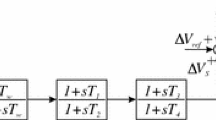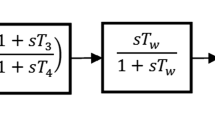Abstract
Power system stability enhancement via robust optimum design of power system stabilizers (PSSs) and thyristor controlled series capacitor (TCSC)-based stabilizers is thoroughly investigated in this paper. The design problem of PSS and TCSC-based stabilizers is formulated as an optimization problem where a reinforcement learning automata-based optimization algorithm is applied to search for the optimal setting of the proposed PSS and CSC parameters. A pole placement based objective function is considered to shift the dominant system eigenvalues to the left in the s-plane. For evaluation of the effectiveness and robustness of the proposed stabilizers, their performances have been examined on a weakly connected power system subjected to different disturbances, loading conditions, and system parameter variations. The nonlinear simulation results and eigenvalues analysis demonstrate the high performance of the proposed stabilizers and their ability to provide efficient damping of low frequency oscillations. In addition, it is observed that the proposed CSC has greatly improved the voltage profile of system under severe disturbances.
Similar content being viewed by others
References
Yu YN (1983) Electric power systems dynamics. Academic Press, New York
Sauer PW, Pai MA (1998) Power system dynamics and stability. Printice Hall, Englewood Cliffs
de Mello FP, Concordia C (1969) Concepts of synchronous machine stability as affected by excitation control. IEEE Trans PAS 88: 316–329
Kundur P (1979) Power system stability and control. EPRI Press, Palo Alto
Kundur P, Klein M, Rogers GJ, Zywno MS (1989) Application of power syatem stabilizers for enhacement of overall system stability. IEEE Trans PWRS 4(2): 614–626
Lim CM, Elangovan S (1985) Desgin of stabilizers in multimachine power systems. IEE Proc C 132(3): 146–153
Yu YN, Li Q Pole-placement power system stabilizers design of an unstable nine-machine system. IEEE Trans PWRS 5(2):353–358
da Cruz JJ, Zanetta LC (1997) Stabilizer design for multimachine power systems using mathematical programming. Int J Electr Power Energy Syst 19(8): 519–523
Maslennikov VA, Ustinov SM (1996) The optimization method for coordinated tuning of power system regulators. In: Proceedings of 12th power system computation conference PSCC, Dresden, pp 70–75
Osheba SM, Hogg BW (1982) Performance of state space controllers for turbogenerators in multimachine power systems. IEEE Trans PAS 101(9): 3276–3283
Xia D, Heydt GT (1983) Self-tuning controller for generator excitation control. IEEE Trans PAS 102: 1877–1886
Samarasinghe V, Pahalawaththa N (1997) Damping of multimodal oscillations in power systems using variable structure control techniques. IEE Proc Genet Trans Distrib 144(3): 323–331
Abido MA, Abdel-Magid YL (1999) Hybridizing rule-based power system stabilizers with genetic algorithms. IEEE Trans Power Syst 14(2): 600–607
Noroozian M, Anderson G (1993) Power flow control by use of controllable series components. IEEE Trans Power Deliv 8(3): 1420–1429
Rahim A, Nassimi S (1996) Synchronous generator damping enhancement through coordinated control of exciter and SVC. IEE Proc Genet Trans Distrib 143(2): 211–218
Mahran A, Hogg B, Al-Sayed ML (1992) Coordinated control of synchronous generator excitation and static VAR compensator. IEEE Trans Energy Convers 7(4): 615–622
Chen X, Pahalawaththa N, Annakkage U, Kumble C (1995) Controlled series compensation for improving the stability of multimachine power systems. IEE Proc C 142: 361–366
Chang J, Chow J (1997) Time optimal series capacitor control for damping inter-area modes in interconnected power systems. IEEE Trans PWRS 12(1): 215–221
Lie T, Shrestha G, Ghosh A (1995) Design and application of fuzzy logic control scheme for transient stability enhancement in power systems. Electr Power Syst Res 33: 17–23
Wang Y, Mohler R, Spee R, Mittelstadt W (1992) Variable structure FACTS controllers for power system transient stability. IEEE Trans PWRS, pp 307–313
Luor T, Hsu Y (1998) Design of an output feedback variable structure thyristor controlled sereis compensator for improving power system stability. Electr Power Syst Res 47: 71–77
Rajkumar V, Mohler R (1994) Bilinear generalized predective control using the thyristor controller sereis capacitor. IEEE Trans PWRS 9(4): 1987–1993
Zhao Q, Jiang J (1998) A TCSC damping controller using robust control theory. Int J Electr Power Energy Syst 20(10): 25–33
Dai X, Liu J, Tang Y, Li N, Chen H (1998) Neural network αth-order inverse control of thyristor controller sereis compensator. Electr Power Syst Res 45: 19–27
Larsen E, Swann D (1981) Applying power system stabilizers. IEEE Trans PAS 100(6): 3017–3046
Tse GT, Tso SK (1993) Refinement of converntional PSS design in multi-machine systems by modal analysis. IEEE Trans PWRS 8(2): 598–605
Baba N (1984) New topics in learning automata theory and applications. In: Lecture notes in control and information sciences. Springer, New York
Narendra KS, Thathachar MAL (1989) Learning automata: an introduction. Printice-Hall, London
Najim K, Poznak AS (1994) Learning automata—theory and applications. Pergamon Press, Oxford
Howell MN, Frost GP, Gordon TJ, Wu QH (1997) Continuous action reinforcement learning applied to vehicle suspension control. Mechatronics 7(3): 263–276
Howell MN, Best MC (2000) On-line PID tuning for engine idle-speed control using continuous action reinforcement learning automata, Pergamon. Control Eng Pract 8: 147–154
Howell MN, Gordon TJ (2001) Continuous action reinforcement learning automata and their application to adaptive digital filter design, Pergamon. Eng Appl Artif Intell 14: 549–561
Kashki M, Abdel-Magid YL, Abido MA (2008) A reinforcement learning automata optimization approach for optimum tuning of PID controller in AVR system. In: IEEE international conference on intelligent computing ICIC, China
Kashki M, Gharaveisi A, Kharaman F (2006) Application of CDCARLA technique in designing Takagi-Sugeno fuzzy logic power system stabilizer (PSS). In: Proceedings of IEEE 1st international conference on power and energy PECon, November, pp 280–285
Kashki M, Abdel-Magid YL (2008) Optimum tuning of power system stabilizers via CDCARLA optimization technique. Int J Power Energy Artif Intell 1: 34–41
Kashki M, Abdel-Magid YL (2008) Application of CDCARLA optimization technique in designing power system stabilizer (PSS). Second power engineering and optimization conference PEOCO, Malaysia
Kashki M, Gharaveisi A, Kharaman F (2007) An optimum design of Takagi-Sugeno fuzzy logic controller of beam and ball system using CDCARLA technique. In: Fifteenth Iranian conference on electrical engineering ICEE
Abido MA (1999) A novel approach to conventional power system stabilizer design using Tabu search. Int J Electr Power Energy Syst 21(6): 443–454
Author information
Authors and Affiliations
Corresponding author
Rights and permissions
About this article
Cite this article
Kashki, M., Abido, M.A. & Abdel-Magid, Y.L. Pole placement approach for robust optimum design of PSS and TCSC-based stabilizers using reinforcement learning automata. Electr Eng 91, 383–394 (2010). https://doi.org/10.1007/s00202-010-0147-5
Received:
Accepted:
Published:
Issue Date:
DOI: https://doi.org/10.1007/s00202-010-0147-5




